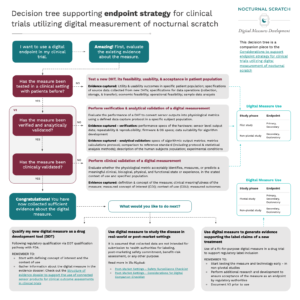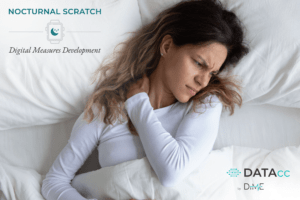
Advancing dermatological digital measures using Nocturnal Scratch resources
“DiMe’s work shows that there is an appetite for collaboration in this space, and we see the value too. Beyond industry interest, DiMe’s projects are faster, cheaper, and more agile than many other collaborative projects or consortium efforts – with DiMe, we’re working for 18 months, not 10 years, so the value is very tangible and near term.”
ActiGraph
Industry: Wearable technologies
Location: Pensacola, FL USA
Overview
- Medical-grade wearables for real-world activity, sleep, and mobility data
- End-to-end DHT solutions integrating top-tier hardware, software, and algorithms
- 250+ industry-sponsored clinical trials using ActiGraph’s wearable tech
- 24,000+ scientific papers featuring ActiGraph’s technology
In 2022, ActiGraph took part in DATAcc by DiMe’s Nocturnal Scratch project to address an unmet need: measuring scratching, which affects up to 2.4% of the world’s population, with nighttime scratching being a predominant and burdensome symptom for patients.
DiMe initiated this project to advance the use of digital technologies in addressing atopic dermatitis by examining patients’ actions in their home environment, using digital tools and sensor-generated data to objectively measure and quantify nighttime scratching with low burden. The collaboration team developed resources to guide developers from “what should I measure?” to “this is what I will measure and here’s how I’m going to be successful.”
Read on to learn about ActiGraph’s involvement in this important project and how they are now leveraging the ontologies in their DECODE initiative to make a significant impact on patients struggling with atopic dermatitis and psoriasis:
ActiGraph: Using DiMe’s Resources in Action
Interview with Sylvain Zorman, Director of Digital Health Sciences, ActiGraph
How did you first learn about DiMe and what drew you to join the Nocturnal Scratch project?
I was working with Novartis when I first learned that DiMe was starting a project focused on digital measures and nocturnal scratch. We had an internal program on nocturnal scratch and Atopic Dermatitis (AD), and we spoke with Jen Goldsack [DiMe CEO] about opportunities to collaborate and the benefits of precompetitive collaboration to advancing work to measure nocturnal scratch. Shortly after I started my tenure at ActiGraph, which also has an active portfolio related to AD and nocturnal scratch, and I continued my involvement with the Nocturnal Scratch project and with DiMe more broadly.
What are the greatest values of working with DiMe on pre-competitive collaborations?
First, the Nocturnal Scratch project filled a huge unmet need. Measuring scratching is core to identifying and treating AD, a condition that impacts over 2% of the population—often in debilitating ways.
The most disruptive symptom that patients experience in many dermatological conditions is itch. This unpleasant sensation leads to scratching, further disrupting the skin barrier and resulting in intensified itch; a sequence referred to as the itch-scratch cycle. This cycle is particularly detrimental during times when nocturnal scratch disrupts sleep, leading to sleep impairment. Nocturnal scratch is defined as the action of rhythmic and repetitive skin contact movement performed during a delimited time period of intended and actual sleep, not necessarily restricted to any specific time of the day or night.
Across AD, as well as many other conditions, there are always companies doing the exact same thing in silos trying to find their path forward. However, in this case, DiMe led cross-disciplinary stakeholders in a unified, coordinated path to align on ontologies, measures of meaningful aspects of health, and measures so that the industry as a whole could advance our work faster and more efficiently – putting our efforts into setting standards and then individually leveraging those standards and that work to advance our own missions.
Second, by working in a consortium, we reached more people more quickly and really developed the new norms and best practices for the industry. This work has gotten significant traction because of the caliber of partners that participated.
Lastly, it allowed us to be more thoughtful about the time and money put into these efforts – by collaborating, we were able to coordinate our efforts rather than duplicate work in silos across many companies.
How did these resources help advance the work being done at ActiGraph?

At ActiGraph, we immediately put the ontologies to use and found value in knowing we were on the right track with what to measure. You may question that – nocturnal scratch, nighttime scratching, that’s pretty straightforward, but it’s not. For a competitive tech company, we need to know what our exact targets are so we can track and measure the right things properly. Having industry-developed and approved ontologies gave us a jump start and confirmed we were on the right track.
We also found significant value in the patient survey. Being a part of the discussions with patients and payers and gaining intel into meaningful aspects of health is something we otherwise would not have had working individually as ActiGraph versus part of the broader coalition.
We are actively working with FDA and EMA and as part of those discussions, we need to demonstrate that our product is meaningful to patients. Being able to share the quantitative survey results and anecdotes from the patient surveys helps us put our work in perspective and share this with the regulators.
ActiGraph launched the Digital Endpoint Collaboration to accelerate Outcome DEvelopment, (DECODE) in November 2023 to build on DiMe’s work. DECODE-Nocturnal Scratch is a cross-industry working group between ActiGraph and pharmaceutical companies that aims to research and develop a novel, fit-for-purpose digital measure to support patient-focused drug programs for dermatological conditions such as AD and psoriasis.
DECODE is advancing the development of actual technology that is built on past research and collaboration. It will shift our conversations from general topics to specific ones. The regulators and payers can discuss very specific data and findings, uncovering the utility and potential of both the developed technology and the measure itself. The new technology can also help better articulate the measurement of nocturnal scratch, its context of use, concept of interest, etc.
How do you envision continuing your work with DiMe?
We are so inspired by what DiMe is doing to bring together stakeholders and advance digital measures. Not only do we advance our work through the resources developed, we build strong relationships with sponsors, payers, patients, and other project participants.
We are continuing to participate in DiMe projects like CRS and Business Case currently.
DiMe’s work shows that there is an appetite for collaboration in this space, and we see the value too. Beyond industry interest, DiMe’s projects are faster, cheaper, and more agile than many other collaborative projects or consortium efforts – with DiMe, we’re working for 18 months, not 10 years, so the value is very tangible and near term.
